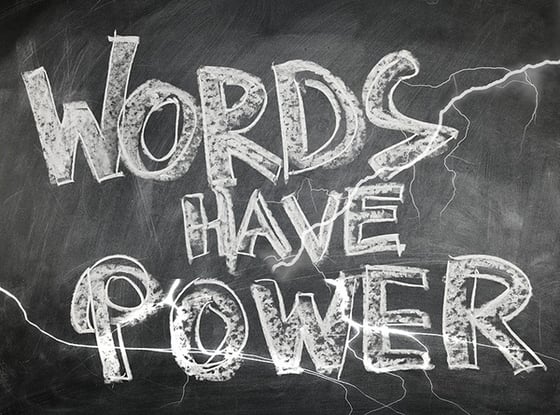
There are no more sentence completion questions on the SAT, so your vocabulary knowledge will be tested with questions that fall under the umbrella of the Words in Context subscore. In this article, I'll give you the inside scoop on what these questions are, what forms they might take in both the Reading and Writing sections, and which strategies work best for solving them accurately.
What Are SAT Words in Context Questions?
Words in Context is a subscore category on the new SAT that includes questions in both the Reading and Writing sections of the test. Your Words in Context subscore is calculated by adding up the points you earn from answering all the questions in this category. There are 18 of these questions per test (ten in the Reading section and eight in the Writing section), so your raw score will range from one to 18. This raw score is converted to a subscore out of 15.
The SAT has seven subscores spanning the different sections of the test that are all converted to scaled scores out of 15. These scores can help identify each student's specific strengths and weaknesses. Here’s a raw score to subscore conversion chart to show what I mean:
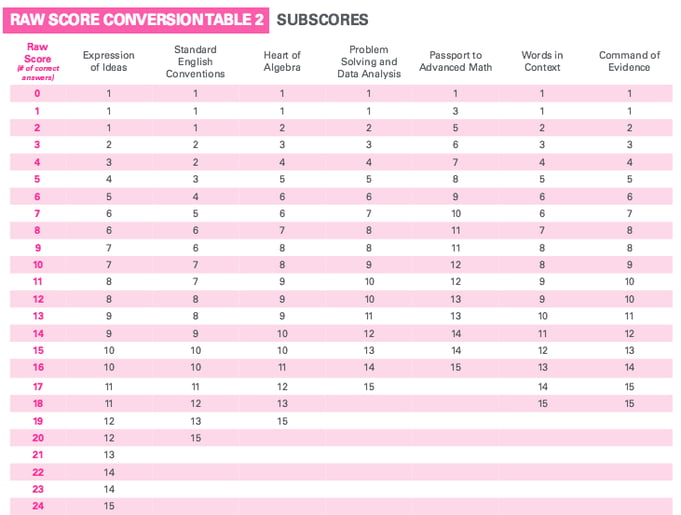
Since there are no more Sentence Completion questions on the new SAT, all vocabulary questions on the new SAT fall into the Words in Context subscore category. Words in Context questions focus on understanding the different meanings of common words and choosing words that are most appropriate for the given circumstances. They won't test your knowledge of advanced vocabulary that you would rarely (if ever) use in daily life like the old SAT did.
On the Reading section, these types of questions will ask you to:
- Use context clues to decide which meaning of a word or phrase is being used in a specific instance (vocabulary in context)
- Decide how the author’s word choice affects meaning, style, and tone in the passage (purpose of words in context)
On the Writing section, they will ask you to:
- Alter word choice to convey the appropriate style or tone (improving word choice)
- Improve syntax of the passage (combining sentences)
- Improve word choice to make the sentence more precise (fill in the blank)
Words in Context questions are important to master because they make up nearly 20 percent the Reading and Writing sections. To give you an idea of exactly what to expect, I’ll provide examples of two Reading questions and three Writing questions that represent all the different types of Words in Context questions you might see on the test.
What Do Words in Context SAT Questions Look Like?
This section includes examples of the various types of words in context questions that you'll come across in both the Reading and Writing sections.
Reading Section
Example #1: Vocabulary in Context
These are the most common types of Words in Context questions on the Reading section. If you’ve ever taken the ACT, you may notice that these are very similar to the vocabulary questions on ACT Reading. They will ask you to choose the best synonym for a given word in the passage based on its context. Here’s an example:

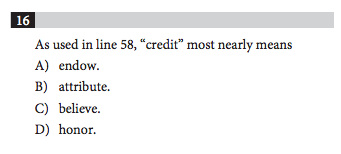
In this sentence, we can see that “credit” means something like “trust” because the demographers are the ones giving us data to suggest that the public transportation is on the upswing. If we trust them, the trend is real. Now that it's clear what we are looking for, it's time to go through the choices.
Choice A is incorrect because “endow” means to equip or furnish someone with something, which isn’t a good replacement for the form of “credit” being used here.
Choice B is also incorrect because “attribute” would mean “cite,” which makes a little bit of sense, but still doesn’t match up with what the original sentence is saying.
Choice C seems to fit pretty well. If we “believe” the demographers, the growing popularity of public transportation is a reality.
Choice D is wrong because “honor" isn't a synonym for “trust,” and taking the demographers at their word is not the same as actively “honoring” them.
Final Answer: C
Example #2: Analyzing Word Choice Rhetorically
You’ll also see questions that ask why certain words are used. Here’s an example along with the section of the passage it references:

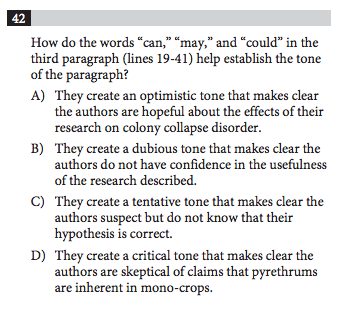
Rather than choosing the correct definition of a word, you must determine why the author uses certain words and how they affect the reader’s perception of the passage. The three words mentioned in the question all indicate hopeful uncertainty, so that's something we should look for in the description of the tone. Also, upon rereading the paragraph, it's clear that this is a very dry, scientific reporting of facts. This clinical quality combined with the words listed seems to indicate that they're used as a means of stating aspects of the authors' hypothesis while clarifying that their beliefs are not yet scientifically confirmed.
Ok, time to look at the choices. Based on the unemotional writing style of the paragraph, Choice A doesn’t fit. There is no descriptive language to suggest either an optimistic (or pessimistic) tone. It simply states the central tenets of the authors' hypothesis along with several supporting facts.
Choice B can also be eliminated because there is nothing to indicate a "dubious" or doubtful tone. Again, the authors are stating their hypothesis in scientific terms without giving us any clear insight into their deeper feelings about it.
Choice C is the most promising so far. It reflects the measured, scientific tone of the paragraph. The authors believe in their hypothesis to a certain extent, but they can’t state their beliefs as facts because they haven’t conducted any experiments to test them.
Finally, Choice D is definitely out. The elaboration in the second part of the sentence is overly specific, and once again, the passage doesn’t have strong enough language to establish a critical tone.
Final Answer: C
 We need to keep the bees healthy so we can put their sweet puke in our tea.
We need to keep the bees healthy so we can put their sweet puke in our tea.
Writing Section
Example #3: Choose the Best Word
These questions are similar to vocabulary in context Reading questions, but they ask you to think in a slightly different way. You have to choose the word that fits best in the passage rather than just determining what the word in the passage means. Here’s an example:


Let's look at what the sentence is trying to say. The officials recently ordered six original paintings of cats from an artist. If the museum privately hired someone to paint the cats, it wouldn't be necessary for any sort of public announcement or "decree" to be issued. Based on this understanding of the sentence, choice A, "NO CHANGE", doesn’t quite work. We're looking for a word that means the same as "ordered" in the sense of "the officials ordered Chinese food" but in a more formal, artistic context.
Choice B is a very promising answer. If you're familiar at all with the art world, you'll know that people and institutions often "commission" works from artists. This is just a fancier way of describing the process of submitting an order for a specific painting that you would like an artist to create. Makes sense considering what we know so far, so we'll keep it in the mix.
Choice C, “forced,” indicates that there was resistance to the creation of the paintings, and there’s no evidence for that. This answer can be crossed out.
Choice D, “licensed,” implies that the paintings already existed and the museum went through a legal process to make them official. This doesn't jive with our understanding of the sentence at all; any licensing, if applicable, would be done after the paintings were completed.
Final Answer: B
Example #4: Improving Word Choice
In some Writing questions that fall under the Words in Context category, you have to choose the word that makes the most sense given the tone of the passage. Here’s an example:

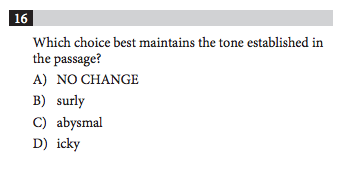 What type of word are we looking for? Let's examine the context. Well, the food was described as being of "terrible quality" earlier in the passage, so we want a synonym for unpalatable or gross. The passage is also a formal historical account, so we're looking for a word that matches with the serious tone.
What type of word are we looking for? Let's examine the context. Well, the food was described as being of "terrible quality" earlier in the passage, so we want a synonym for unpalatable or gross. The passage is also a formal historical account, so we're looking for a word that matches with the serious tone.
Choice A can be ruled out because “sinister” isn’t an appropriate word choice based on what the sentence is describing. “Sinister” means ominous or foreboding. It would be weird to describe train food as “sinister” because this word is reserved for things that are subtly unsettling, not outwardly gross.
Choice B, “surly,” is an adjective that describes a person’s behavior. It can’t be applied to an inanimate object like food, so this choice should be eliminated as well.
Choice C, “abysmal,” seems like a promising choice. Abysmal is a direct synonym for terrible, and it's formal enough to fit with the tone of the passage. Keep this one.
Choice D is incorrect for different reasons than the other answers we eliminated. While "icky" makes sense as a synonym for unpalatable or gross, it doesn't set the right tone. It's way too informal to work with the rest of the passage.
Final Answer: C
Example #5: Combining Sentences
This is another type of question that the SAT puts in the words in context category, though it is a bit different from the other types that I've gone through. In these questions, you just have to decide the best way to combine two sentences that are separate in the original passage. It's still categorized as a Words in Context question because you're asked to modify the phrasing of the sentences so they fit together seamlessly in the context of the paragraph. It requires you to understand how to use language effectively. Here’s an example:

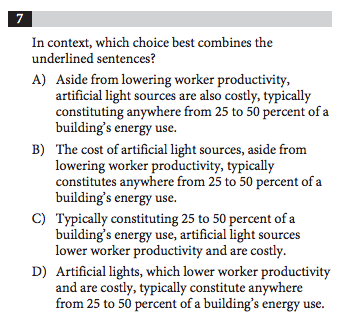
First, let's make sure we understand the content of the original two sentences. The passage has already established that artificial lights lower worker productivity. The purpose of these two sentences is to add another reason to dislike artificial lights: their excessive cost. We're looking for a combination of the two sentences that preserves this purpose and maintains its grammatical integrity.
Choice A looks pretty good. It avoids misplaced modifiers and maintains focus on the costliness of the lights. We can keep this one.
Choice B is incorrect because it indicates that the cost of artificial light sources lowers worker productivity. This is an inaccurate statement because we know from the rest of the passage that the quality of the light source used in the office impacts productivity, not its cost.
Choice C is wrong because it is worded awkwardly and doesn’t emphasize the central point of the two sentences. It gives equal attention to the two negative attributes of artificial light sources when cost is the main focus of this paragraph.
Choice D is wrong because, like choice C, it misses the point of the original sentences. It emphasizes a supporting detail about the lights' energy use while only briefly touching on the subject of their costliness.
 Natural lighting makes for a cheerier and less expensive office. Fluorescent lights will steal your soul if you work under them for long enough.
Natural lighting makes for a cheerier and less expensive office. Fluorescent lights will steal your soul if you work under them for long enough.
Ready to go beyond just reading about the SAT? Then you'll love the free five-day trial for our SAT Complete Prep program. Designed and written by PrepScholar SAT experts, our SAT program customizes to your skill level in over 40 subskills so that you can focus your studying on what will get you the biggest score gains.
Click on the button below to try it out!
4 Tips for Words in Context SAT Questions
Tip #1: Read the Whole Paragraph
These questions are about words (and sentence structure) IN CONTEXT, which means you shouldn’t focus solely on the sentence in which the word appears. This is especially true for questions that ask you to choose the word that fits the tone of the entire paragraph or passage. Always read the surrounding paragraph so that you don’t get an inaccurate impression of the meaning of the word or the author’s intentions.
Tip #2: Predict the Answer
One strategy I would recommend for vocabulary in context questions is to formulate your own idea of what the word means in context before looking at the answer choices. Sometimes looking at the choices can make things more confusing. If you already have an idea in your head of what the answer should be, your thought process is less likely to be disrupted.
Tip #3: Plug It In
A good method for testing out answer choices on Words in Context questions is plugging each of your options back into the sentence. This tip applies to vocabulary in context questions and improving word choice questions. It’s much easier to see the flaws in answer choices if you read the sentence over again using the proposed replacement word. If you plug in the word and it doesn’t feel right, you should reconsider your choice.
Tip #4: Reading, Not Flashcards
Finally, as you're preparing for the SAT, the best thing you can do to improve your performance on these types of questions is to practice your overall reading comprehension. The more you read, the easier it will be for you to discern the various meanings of words based on their contexts. You're far more likely to have seen the word used that way before if you've been reading a lot. See this article for some great ways to develop better reading comprehension in conjunction with studying for words in context questions.
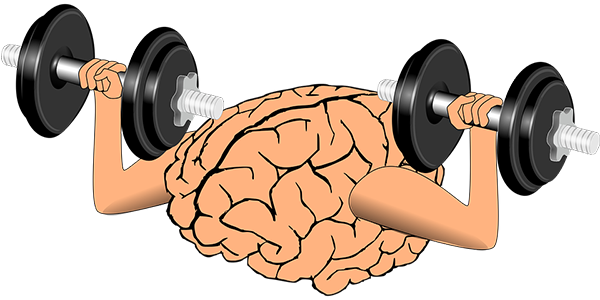 The more you challenge your brain with advanced reading materials, the simpler the passages and vocabulary words on the SAT will seem to you.
The more you challenge your brain with advanced reading materials, the simpler the passages and vocabulary words on the SAT will seem to you.
Conclusion
Words in Context is a subscore category on the SAT that encompasses all questions related to vocabulary knowledge and appropriate word choice. On the Reading section, these questions will ask you to use context clues to choose the correct synonym for a word or to identify the purposes of certain words. On the Writing section, Words in Context questions ask you to improve word choice and combine sentences smoothly.
The strategies I would recommend for solving these types of questions include:
- Reading the whole paragraph containing the word(s) in the question
- Predicting the answer before reading the choices
- Plugging in the answer choices to test them out
- Practicing reading comprehension, not vocab memorization
Unlike the old sentence completion SAT questions, words in context questions don’t require knowledge of advanced vocabulary. If you take a thoughtful, analytical approach to these questions, you should be able to answer them correctly without spending hours studying flashcards.
What's Next?
Struggling with SAT Reading? Here are six strategies that will help you increase your scores to a more competitive level.
You can also check out these five tips to excel on the Writing section if you're more concerned about that part of the test.
If you're looking for some review books to help you out with your studying, check out our reviews of the best books for each section of the SAT.
Want to improve your SAT score by 160 points?
Check out our best-in-class online SAT prep program. We guarantee your money back if you don't improve your SAT score by 160 points or more.
Our program is entirely online, and it customizes what you study to your strengths and weaknesses. If you liked this Reading lesson, you'll love our program. Along with more detailed lessons, you'll get thousands of practice problems organized by individual skills so you learn most effectively. We'll also give you a step-by-step program to follow so you'll never be confused about what to study next.
Check out our 5-day free trial:
Have friends who also need help with test prep? Share this article!

Samantha is a blog content writer for PrepScholar. Her goal is to help students adopt a less stressful view of standardized testing and other academic challenges through her articles. Samantha is also passionate about art and graduated with honors from Dartmouth College as a Studio Art major in 2014. In high school, she earned a 2400 on the SAT, 5's on all seven of her AP tests, and was named a National Merit Scholar.



































 Holly R.
Holly R.